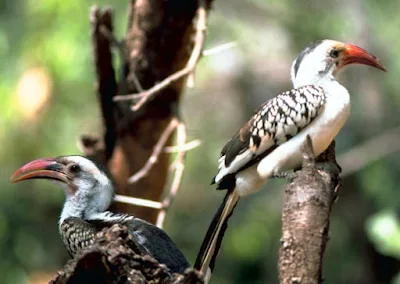30+ Interesting Facts About Hornbills
- There are nearly 60 species of hornbills. They are present in the tropical areas of Africa, Asia, and Oceania.
- Hornbills have extra long, curved bills. However, the most distinguishing feature in several species is the casque (helmet) above their beak.
- Unlike other birds with three-lobed kidneys, hornbills have two-lobed kidneys. Their kidneys contain anterior and exterior lobes but no middle lobe. (Source)
- The bill and casque in hornbills apply much pressure on the neck. Therefore, their first two neck vertebrae join together to support this weight.
- Like many other birds, the long beaks of hornbills assist them in getting rid of extra heat in warm climates. The thermoregulation of hornbill beaks starts functioning at air temperatures above 30 C. (Source)
- Several hornbill species have bright orange-red beaks and casques. It happens due to secretion from a gland. The bird rubs the beak beneath its tail, stimulating a gland that releases orange-red oil.
- Yellow-casqued hornbills can distinguish between different calls of Diana monkeys. The alarm call of these primates is unique for eagles and leopards. Hornbills face danger from eagles and respond only to monkeys’ alarms about approaching crowned eagles. These are the first birds known to have this feature. (Source)
- Southern ground hornbill is the largest, while the red-billed dwarf hornbill is the smallest among these birds. The great hornbill is the largest forest-dwelling hornbill.

Red-billed hornbills are the smallest among hornbills - Hornbills have binocular vision like many other birds. But unlike other bird species, the bill in hornbill comes in its field of vision and reduces the width of the binocular field. However, it assists hornbills in grasping various items on the tip of the bill accurately. (Source)
- Most hornbills are omnivores. They eat fruits, insects, and small animals.
- Many hornbill species are monogamous. The most prominent is the Monteiro’s hornbill of Africa, where both males and females remain strictly monogamous.
- Hornbill habitats include forests, shrubland, savannas, and rocky areas. They make nests in trees or on rocky cliffs.
- Toucans and hornbills have similar appearances and diets. However, they are not related, and their similarities are due to their identical environments.
- Hoopoes and wood hoopoes are the closest relatives of hornbills.
- Male hornbills are usually bigger than females. In a few species, the males are up to 66% larger than female hornbills. The casque is also larger in males than in females.
- Casques in hornbills perform several functions. They make the calls more audible by resonating with the bird’s sound. Hornbills also use them to dig soil and peel off tree bark. Heavy casques in some species make the bills work like a hammer.
- In all forest-dwelling hornbills, females enclose themselves inside the nest before incubation with assistance from males. They construct walls using mud, dung, soil, and other objects to protect females and eggs. A small hole in the wall allows the male to bring food. The female leaves the nest after hatching eggs, but the newborns remain inside after rebuilding the wall.
- Forest-dwelling hornbills play a vital role in dispersing seeds of various fruits in forests.
- The number of eggs is different in various hornbill species. Large birds lay one or two eggs, while smaller species can have up to seven eggs.
- In contrast to other birds, female hornbills shed their feathers simultaneously while in the nest. However, this unique molting process has no link to the darkness of the nest cavity. (Source)
- Female hornbills keep the nest clean during incubation by throwing the waste outside using a small opening.
- All the hornbill species are arboreal except the two ground-dwelling hornbills. Abyssinian ground hornbill and southern ground hornbill are native to Africa. They can fly but spend most of their time on the ground. Unlike other omnivore hornbills, these birds are mainly carnivorous. Their prey also includes animals like snakes and small monkeys.
- Hornbills
form mutually beneficial relationships with other animals. They inform
mongooses about any danger and eat insects with their assistance in return.

Hornbills have mutually-beneficial relationship with mongooses - Elephants in Africa and bears in Asia provide suitable nesting places for hornbills by pulling down tree branches.
- According to estimates, hornbills initially appeared in Africa. Some forest-dwelling species later moved to Asia.
- According to a Malaysian legend, the spoon made from the beak of hornbills can change color when in contact with the poison. Currently, all the Asian hornbill species are under threat due to the illegal trade of their casque and habitat loss. (Source)
- Some hornbill species have eyelashes, a less common feature in birds. Unlike mammalian eyelashes, these bird eyelashes are the product of modified feathers and protect the bird’s eyes from sun and debris.
- Male hornbill brings food to female for a year before mating.
- Various species of hornbills can live for up to 50 years. Large species, like southern ground hornbills and great hornbills, can live for 70 years, one of the longest among birds.
- Hornbills pose no danger to humans. They would fly away if disturbed.
- Southern ground hornbill produces loud calls that resemble a lion’s roar.



Comments
Post a Comment